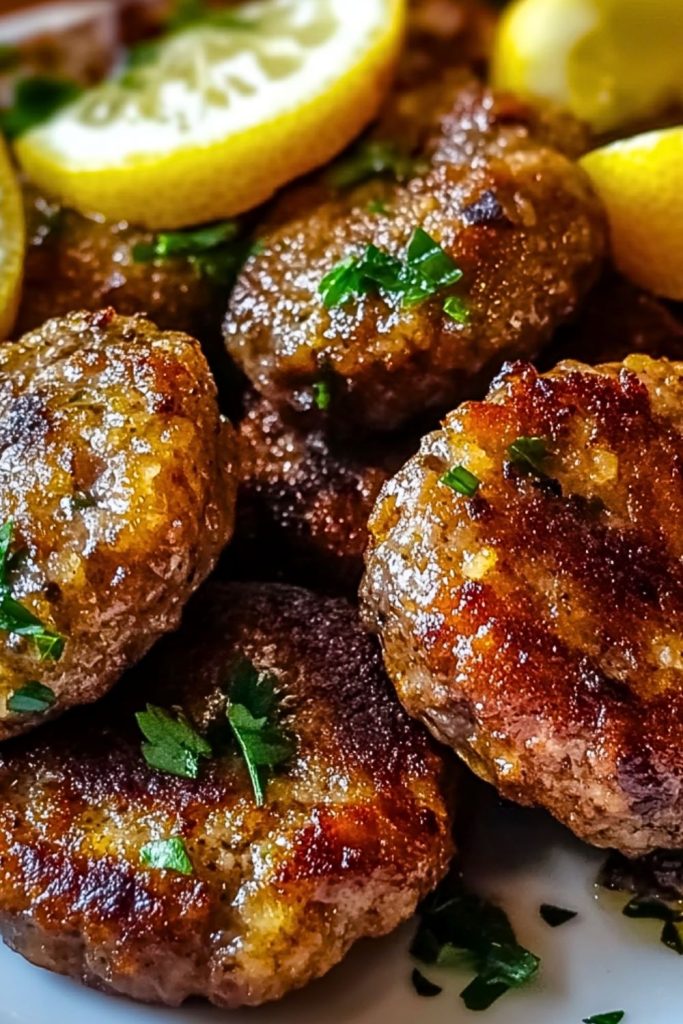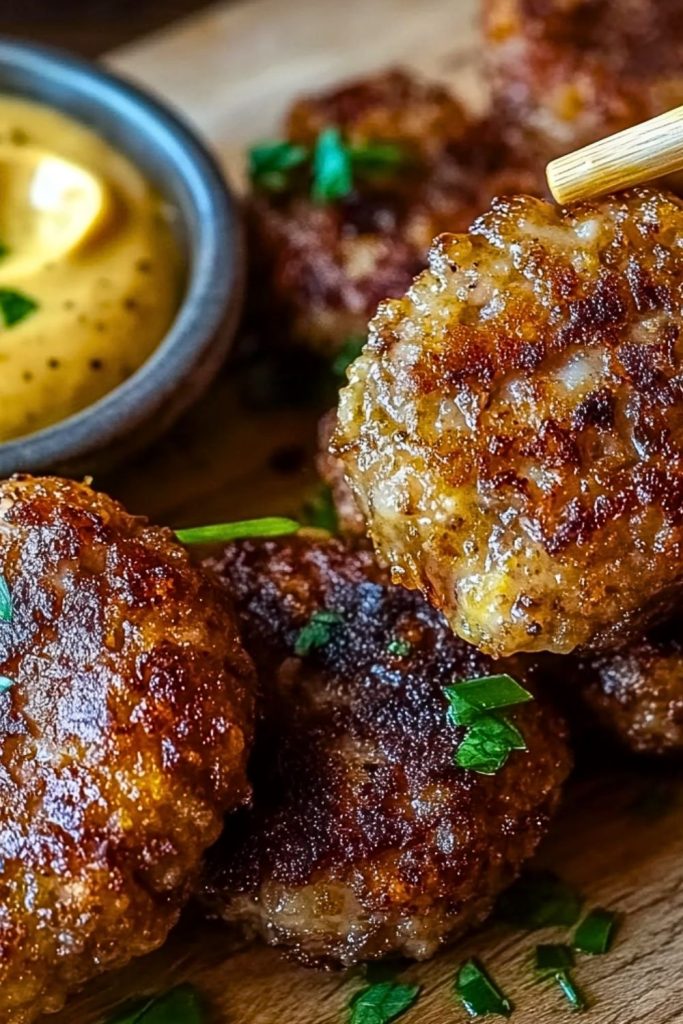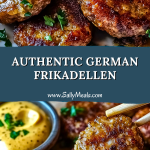Growing up, I always associated the scent of sizzling meat patties with something special—a family dinner, a weekend feast, or even a quick comforting lunch. German Frikadellen are everything I love about rustic, homey cooking: flavorful, juicy, and loaded with savory herbs and spices. These traditional meat patties may look simple, but don’t let their appearance fool you—they’re bursting with flavor and perfect for nearly any occasion.

What makes Frikadellen different from typical meatballs or burger patties is their unique blend of ingredients and the method of preparation. With a crispy brown crust on the outside and a moist, seasoned interior, they strike a beautiful balance between texture and taste. Whether you’re serving them hot off the skillet or letting them cool for a picnic, Frikadellen always manage to steal the show.
Why You’ll Love This Authentic German Frikadellen
These Frikadellen aren’t just meat patties—they’re little bites of German comfort food history. You’ll love how quickly they come together with pantry staples and just a few fresh ingredients. They’re also incredibly versatile: serve them as a main course, pack them in lunchboxes, or turn them into sliders. Plus, they freeze well, making them ideal for meal prep.
What Type of Ground Meat Should I Use for Authentic German Frikadellen?
Traditionally, Frikadellen are made using a combination of ground pork and ground beef. The pork brings a juicy, slightly fatty richness, while the beef adds depth and robustness. I’ve also tried it with only one type of meat in a pinch, and while it still tastes good, the duo brings out the best balance of texture and flavor.
If you’re after authenticity and that unmistakable German taste, go for a 50/50 mix of beef and pork. It browns beautifully and holds moisture well. Make sure the meat isn’t too lean—you want a little fat to help bind the ingredients and ensure juiciness in every bite.
Options for Substitutions
Frikadellen are adaptable, which is one of the reasons I love making them. Here are a few ways to tweak the recipe based on what you have or your dietary preferences:
Ground Turkey or Chicken
These leaner meats are great for a lighter version, but be sure to add a splash of milk or extra breadcrumbs to help with moisture.
Gluten-Free
Use gluten-free breadcrumbs or crushed rice crackers instead of traditional breadcrumbs.
Dairy-Free
Simply omit the milk or use a non-dairy substitute like unsweetened almond milk if your recipe includes milk-soaked bread.
Vegetarian
Try mashed chickpeas or a blend of cooked lentils and mushrooms. You’ll need extra seasoning, but the texture comes surprisingly close!
Seasoning Twists
Though traditional German seasoning sticks with salt, pepper, and sometimes marjoram or nutmeg, you can add garlic, smoked paprika, or chopped parsley to make it your own.
Ingredients for This Authentic German Frikadellen
Ground Beef and Ground Pork
The classic base—using both ensures a juicy, flavorful patty. The fat from the pork complements the beef beautifully.
Stale Bread or Breadcrumbs
Soaked in water or milk, this acts as a binder and gives the Frikadellen their signature soft texture. Fresh bread won’t do—day-old or slightly dry works best.
Onion
Finely chopped and lightly sautéed for a mellow sweetness and depth. Raw onion can be too harsh, so I always cook it first.
Egg
Helps bind the ingredients together so the patties hold their shape during cooking.
Mustard
A small spoonful adds a subtle tang and rounds out the flavors. German mustard is ideal, but Dijon works too.
Salt and Pepper
Essential seasonings that enhance the meat without overpowering it. Go generous on the pepper if you like a little kick.
Fresh Parsley
Adds brightness and a touch of earthiness—chopped parsley lifts the entire flavor profile.
Nutmeg or Marjoram (Optional)
These traditional spices add a hint of warmth and authenticity. Nutmeg offers subtle spice, while marjoram gives a herbal note.
Oil or Butter (for frying)
Used for achieving that golden-brown crust. I prefer a mix of butter and neutral oil for flavor and even browning.

Step 1: Soak the Bread
Begin by taking your stale bread (or breadcrumbs) and soaking it in a bit of milk or water until it’s completely soft. If using bread slices, squeeze out the excess liquid after soaking. This step gives the Frikadellen their signature tender texture.
Step 2: Sauté the Onions
While the bread is soaking, finely chop your onion and gently sauté it in a small amount of oil until soft and translucent. This mellows the sharpness and brings out the onion’s natural sweetness.
Step 3: Mix the Ingredients
In a large bowl, combine the ground beef, ground pork, soaked bread, sautéed onions, egg, mustard, parsley, salt, pepper, and optional nutmeg or marjoram. Use your hands to gently mix everything together—don’t overwork it or the patties will be dense.
Step 4: Shape the Patties
Wet your hands slightly (this prevents sticking), then form the mixture into oval or round patties, about the size of your palm. Aim for about 1 inch thick so they cook through evenly without drying out.
Step 5: Pan-Fry Until Golden
Heat a combination of butter and neutral oil in a skillet over medium heat. Fry the Frikadellen in batches, allowing enough space between them. Cook for about 4–5 minutes per side, or until they develop a deep golden-brown crust and are fully cooked in the center.
Step 6: Let Them Rest
Once cooked, transfer the patties to a plate lined with paper towels to rest briefly. This lets the juices redistribute and keeps the outer crust crisp.
How Long to Cook the Authentic German Frikadellen
The total cooking time for Frikadellen typically falls between 8 to 10 minutes, depending on their thickness. Over medium heat, each side should be pan-fried for about 4 to 5 minutes. You’ll know they’re done when they have a deeply golden, crispy crust and the internal temperature reaches at least 160°F (71°C) if you’re using a thermometer.
Keep in mind that thinner patties cook a bit faster, while thicker ones may need a few extra minutes. Don’t rush the cooking process—medium heat allows for thorough cooking without burning the exterior.
Tips for Perfect Frikadellen
1. Use Day-Old Bread for the Best Texture
Fresh bread won’t soak properly and can lead to uneven mixing. Slightly stale bread absorbs liquid better and binds the meat more uniformly.
2. Sauté the Onions First
Raw onions can be overpowering and may release moisture that prevents browning. Cooking them softens the flavor and helps integrate them smoothly into the mix.
3. Don’t Overmix the Meat
Gently fold everything together with your hands. Overworking the mixture can result in tough, rubbery patties.
4. Let the Patties Rest Before Cooking
Chill them for 10–15 minutes after shaping. This helps them hold their shape in the pan and makes them easier to flip.
5. Combine Butter and Oil for Frying
Butter gives flavor, while oil prevents burning. The combination ensures even browning and a beautiful, crisp crust.
6. Use a Cast-Iron or Nonstick Skillet
These provide even heat and prevent sticking, which is essential for getting that gorgeous golden crust.
7. Flip Only Once
Let the patties develop a crust before turning. Flipping too soon or too often can break them apart or leave them pale.
Watch Out for These Mistakes While Cooking
Using Lean Meat Only
Frikadellen need fat for moisture and flavor. A mix of lean and fatty meat (like pork and beef) prevents them from turning out dry and crumbly.
Skipping the Bread Soak
Dry breadcrumbs thrown in without soaking won’t provide the same tender texture. Always soak your bread to create that soft interior.
Cooking on High Heat
Too much heat scorches the outside while leaving the inside raw. Medium heat is your best friend—golden crust, juicy center.
Overcrowding the Pan
When patties are too close together, they steam instead of fry. Always leave space for air circulation and even browning.
Neglecting to Season Generously
The mixture needs a good amount of salt and pepper to bring out the flavor. Don’t be shy here—season evenly and taste-test a small patty first if needed.
Forgetting to Rest the Patties
Resting both before and after cooking improves texture and flavor. It helps them firm up before hitting the pan and lets juices redistribute once cooked.
What to Serve With Authentic German Frikadellen?
Kartoffelsalat (German Potato Salad)
A tangy, vinegar-based potato salad balances the richness of the patties beautifully.
Sauerkraut
This classic fermented side adds brightness and a slight tang that cuts through the savory meat.
Pretzel Rolls or Crusty Bread
Perfect for turning Frikadellen into sliders or mopping up juices on the plate.
Braised Red Cabbage
Sweet and sour red cabbage is a traditional side that complements the warm spices of the meat.
Mashed Potatoes
Creamy, buttery mashed potatoes offer a hearty and comforting pairing.
Green Bean Salad
A crisp, refreshing vegetable option with vinaigrette brings balance to the dish.
Mustard or Horseradish Sauce
A sharp, creamy condiment on the side enhances the meat’s flavor with every bite.
Cucumber Salad
Thinly sliced cucumbers in a light dill dressing add freshness and crunch.
Storage Instructions
Frikadellen are just as enjoyable the next day—maybe even better after the flavors have settled. Once they’ve cooled to room temperature, place them in an airtight container and store in the refrigerator for up to 4 days.
To reheat, warm them in a skillet over low heat or in the oven at 325°F (160°C) for about 10 minutes until heated through. Microwaving works too, but can soften the crispy exterior.
For longer storage, freeze cooked Frikadellen individually wrapped in plastic wrap, then place them in a freezer-safe bag. They’ll keep for up to 3 months. Defrost overnight in the fridge before reheating.
Estimated Nutrition (per patty, based on a recipe making 6 servings)
- Calories: ~290 kcal
- Protein: 18g
- Fat: 21g
- Saturated Fat: 7g
- Carbohydrates: 6g
- Fiber: 0.5g
- Sugars: 1g
- Sodium: 420mg
- Cholesterol: 80mg
These values are approximate and can vary depending on the exact meat-to-fat ratio and specific ingredient brands you use.
Frequently Asked Questions
Can I make Frikadellen in the oven?
Yes, you can bake them at 375°F (190°C) for 20–25 minutes, flipping halfway through. They won’t be as crisp as pan-fried but still taste great.
What’s the difference between Frikadellen and meatballs?
Frikadellen are larger, flatter, and often pan-fried, while meatballs are round and usually baked or simmered in sauce. Seasoning profiles also differ, with Frikadellen leaning toward mustard, onion, and herbs.
Can I make them ahead of time?
Absolutely! You can prepare the patties a day ahead and keep them covered in the fridge until ready to cook. They also freeze well pre- or post-cooking.
Do I have to use both pork and beef?
No, but the combination creates a juicy, well-balanced flavor. Using only beef can be a bit drier; using only pork will be richer and softer.
What’s the best bread to use?
Stale white bread or rolls work best. Avoid strongly flavored or seeded breads that might overpower the meat.
How do I keep them from falling apart?
Make sure your mixture isn’t too wet, don’t skip the egg, and let them rest before cooking. Also, don’t flip them too early while frying.
Can I make a vegetarian version?
Yes! A mixture of mashed beans or lentils with breadcrumbs, onions, and herbs works well. The texture will differ, but the taste is still comforting and hearty.
Are Frikadellen served hot or cold?
Both! They’re traditionally served hot but are also delicious cold in sandwiches or picnic spreads.
Conclusion
Authentic German Frikadellen bring old-world charm and heartiness to your kitchen with just a few basic ingredients. They’re quick to prepare, easy to adapt, and perfect for everything from family dinners to lunchbox favorites. Whether you stick to the traditional mix of pork and beef or try a modern variation, these savory patties promise to deliver comfort and flavor in every bite. Once you try them, I guarantee they’ll earn a regular spot on your meal rotation.

Authentic German Frikadellen
- Prep Time: 15 minutes
- Cook Time: 10 minutes
- Total Time: 25 minutes
- Yield: 6 patties 1x
Description
Authentic German Frikadellen are savory pan-fried meat patties made with a mix of ground beef and pork, seasoned with onions, herbs, and spices. Juicy on the inside with a crispy crust, they are a beloved German comfort food perfect for any meal.
Ingredients
- 250g ground beef
- 250g ground pork
- 1 small onion, finely chopped
- 2 slices of stale white bread
- 100ml milk (or water for soaking bread)
- 1 egg
- 1 tsp mustard (preferably German-style)
- 2 tbsp chopped fresh parsley
- 1/2 tsp salt
- 1/4 tsp black pepper
- A pinch of ground nutmeg or marjoram (optional)
- 1 tbsp butter
- 1 tbsp neutral oil (like canola or sunflower)
Instructions
- Soak the stale bread in milk or water until fully soft, then squeeze out excess liquid.
- Sauté the chopped onion in a little oil until soft and translucent. Let cool slightly.
- In a large mixing bowl, combine ground beef, ground pork, soaked bread, sautéed onion, egg, mustard, parsley, salt, pepper, and optional nutmeg or marjoram.
- Gently mix all ingredients together with your hands until just combined. Do not overmix.
- Wet your hands and form the mixture into 6 oval-shaped patties, about 1 inch thick.
- Heat butter and oil in a skillet over medium heat.
- Fry the patties in batches, about 4–5 minutes per side, until golden brown and cooked through.
- Transfer to a plate lined with paper towels and let rest before serving.

